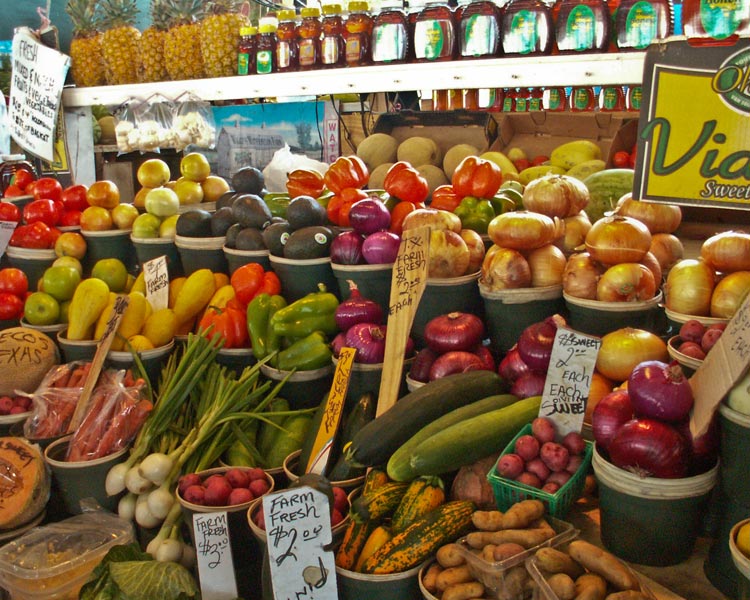Food Miles
Students explore the economic and environmental benefits of buying locally grown food.
Background
Lesson Activities
Recommended Companion Resources
Credits
Author
Lynn Wallin | Utah Agriculture in the Classroom and National Center for Agricultural Literacy (NCAL)
Acknowledgements
Photo Credit Allen Sheffield
Sources
- https://www.nal.usda.gov/aglaw/local-foods#quicktabs-aglaw_pathfinder=1
- http://www.foodsystemprimer.org/food-distribution/
- https://www.amiba.net/resources/multiplier-effect/
- Statistics used in the Where Does Your Food Dollar Go? graphic compiled by American Farm Bureau Foundation for Agriculture Food and Farm Facts 2021 (Sources: ERS, Farm Production Expenses and Food Dollar Series)
- https://www.foodsafety.gov/news/fsma.html
Standards
Indiana Content Area Standards
-
Social Studies. Grade 4: Geography: Standard 3
Students explain how the Earth/sun relationship influences the climate of Indiana; identify the components of Earths physical systems; describe the major physical and cultural characteristics of Indiana; give examples of how people have adapted to and modified their environment, past and present; identify regions of Indiana, and compare the geographic characteristics of Indiana with states and regions in other parts of the world/country.
- 4.3.11 Human Systems: Examine Indiana’s international relationships with states and regions in other parts of the world.
-
Social Studies.Grade 5: Geography: Standard 3
Students describe the influence of the Earth/sun relationship on climate and use global grid systems; identify regions; describe physical and cultural characteristics; and locate states, capitals and major physical features of the United States. They also explain the changing interaction of people with their environment in regions of the United States and show how the United States is related geographically to the rest of the world.
- 5.3.6 Physical Systems: Use maps to describe the characteristics of climate regions of the United States.
-
Social Studies. Grade 3: Economics: Standard 4
Students explain how people in the local community make choices about using goods, services and productive resources; how they engage in trade to satisfy their economic wants and needs; how they use a variety of sources to gather and apply information about economic changes in the community; and how they compare costs and benefits in economic decision making.
- 3.4.2 Economics: Give examples of goods and services provided by local business and industry.
- 3.4.3 Economics: Give examples of trade in the local community and explain how trade benefits both parties.
- 3.4.7 Economics: Illustrate how people compare benefits and costs when making choices and decisions as consumers and producers.
-
English Language Arts.Grade 3.SL.1
Listen actively and adjust the use of spoken language (e.g., conventions, style, vocabulary) to communicate effectively with a variety of audiences and for different purposes.
- Discussion and Collaboration.3.SL.2.1: Engage effectively in a range of collaborative discussions (one-on-one, in groups, and teacher-led) on grade- appropriate topics and texts, building on others ideas and expressing personal ideas clearly.
-
English Language Arts.Grade 4.SL.1
Listen actively and adjust the use of spoken language (e.g., conventions, style, vocabulary) to communicate effectively with a variety of audiences and for different purposes.
- Discussion and Collaboration.4.SL.2.1: Engage effectively in a range of collaborative discussions (one-on-one, in groups, and teacher-led) on grade- appropriate topics and texts, building on others ideas and expressing personal ideas clearly.
-
English Language Arts.Grade 5.SL.1
Listen actively and adjust the use of spoken language (e.g., conventions, style, vocabulary) to communicate effectively with a variety of audiences and for different purposes.
- Discussion and Collaboration.5.SL.2.1: Engage effectively in a range of collaborative discussions (one-on-one, in groups, and teacher-led) on grade- appropriate topics and texts, building on others ideas and expressing personal ideas clearly.
 organizer to each student. Throughout this activity, as the students are discussing the topic, they should make notes concerning the advantages and disadvantages of eating local on their graphic organizer.
organizer to each student. Throughout this activity, as the students are discussing the topic, they should make notes concerning the advantages and disadvantages of eating local on their graphic organizer.